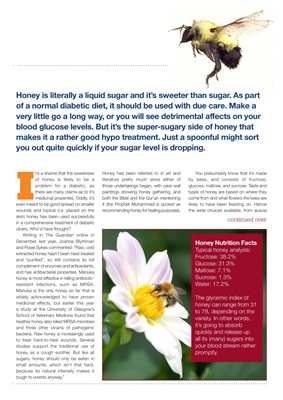
It's a shame that the sweetness
of honey is likely to be a
problem for a diabetic, as
there are many claims as to it's
medicinal properties. Oddly, it's
even meant to be good spread on smaller
wounds and topical (i.e. place don the
skin) honey has been used successfully
in a comprehensive treatment of diabetic
ulcers. Who'd have thought?
Writing in The Guardian online in
December last year, Joanna Blythman
and Rosie Sykes commented: "Raw, cold
extracted honey hasn't been heat-treated
and "purified", so still contains its full
complement of enzymes and antioxidants,
and has antibacterial properties. Manuka
honey is most effective in killing antibioticresistant
infections, such as MRSA.
Manuka is the only honey so far that is
widely acknowledged to have proven
medicinal effects, but earlier this year
a study at the University of Glasgow's
School of Veterinary Medicine found that
heather honey also killed MRSA microbes
and three other strains of pathogenic
bacteria. Raw honey is increasingly used
to treat hard-to-heal wounds. Several
studies support the traditional use of
honey as a cough soother. But like all
sugars, honey should only be eaten in
small amounts, which isn't that hard,
because its natural intensity makes it
tough to overdo anyway."
continued over
Honey Nutrition Facts
Typical honey analysis:
Fructose: 38.2%
Glucose: 31.3%
Maltose: 7.1%
Sucrose: 1.3%
Water: 17.2%
The glycemic index of
honey can range from 31
to 78, depending on the
variety. In other words,
it's going to absorb
quickly and release up
all its (many) sugars into
your blood stream rather
promptly.
Honey is literally a liquid sugar and it's sweeter than sugar. As part
of a normal diabetic diet, it should be used with due care. Make a
very little go a long way, or you will see detrimental affects on your
blood glucose levels. But it's the super-sugary side of honey that
makes it a rather good hypo treatment. Just a spoonful might sort
you out quite quickly if your sugar level is dropping.
Honey has been referred to in art and
literature pretty much since either of
those undertakings began, with cave wall
paintings showing honey gathering, and
both the Bible and the Qur'an mentioning
it (the Prophet Muhammad is quoted as
recommending honey for healing purposes).
You presumably know that it's made
by bees, and consists of fructose,
glucose, maltose, and sucrose. Taste and
types of honey are based on where they
come from and what flowers the bees are
likely to have been feasting on. Hence
the wide choices available, from acacia